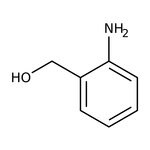Search Thermo Fisher Scientific
Alcool 2-aminobenzylique, 98 %, Thermo Scientific Chemicals



Alcool 2-aminobenzylique, 98 %, Thermo Scientific Chemicals
Identifiants chimiques
Spécifications
Description
This Thermo Scientific Chemicals brand product was originally part of the Alfa Aesar product portfolio. Some documentation and label information may refer to the legacy brand. The original Alfa Aesar product / item code or SKU reference has not changed as a part of the brand transition to Thermo Scientific Chemicals.
L’alcool 2-aminobenzylique est cyclé de manière oxydative avec un ensemble de cétones dans le dioxane à 80°C en présence d’un catalyseur de ruthénium et de KOH pour donner les quinolines correspondantes. Il subit une oxydation catalysée par des espèces hétérotrimétalliques de RuMnMn sur une surface d’hydrotalcite en présence d’O2 pour produire du 2-aminobenzaldéhyde. Il a été utilisé dans la synthèse de 2-hydroxyméthylcarbanilate d’éthyl.
Solubilité
Très soluble dans l’eau.
Remarques
Conserver à température ambiante. Incompatible avec les agents oxydants.
Figures
Documentation et téléchargements
Certificats
Foire aux questions (FAQ)
Citations et références
Sécurité et manipulation
Classification of the substance or mixture
CLP classification - Regulation(EC) No 1272/2008
Label Elements
Signal Word
Warning
Hazard Statements
H302 - Harmful if swallowed
H315 - Causes skin irritation
H319 - Causes serious eye irritation
H335 - May cause respiratory irritation
Precautionary Statements
P261 - Avoid breathing dust/fume/gas/mist/vapors/spray
P280 - Wear protective gloves/protective clothing/eye protection/face protection
P301 + P312 - IF SWALLOWED: Call a POISON CENTER or doctor/physician if you feel unwell
P302 + P352 - IF ON SKIN: Wash with plenty of soap and water
P305 + P351 + P338 - IF IN EYES: Rinse cautiously with water for several minutes. Remove contact lenses, if present and easy to do. Continue rinsing